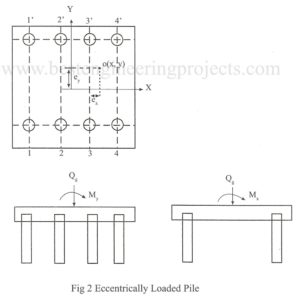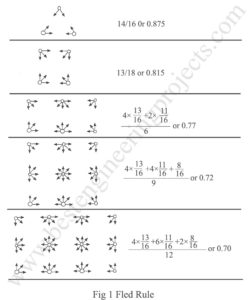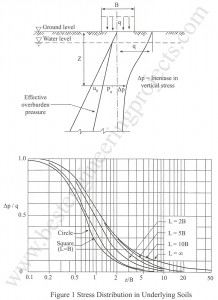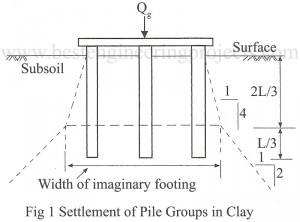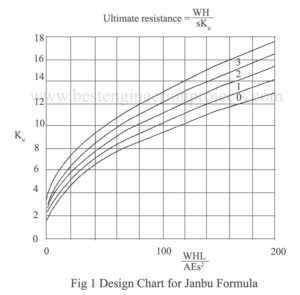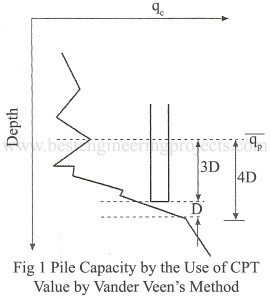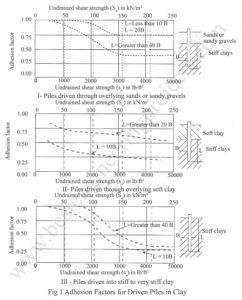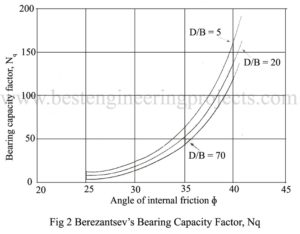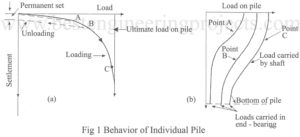When group of piles are loaded centrally over the pile cap, the load is equally distributed on all piles, provided the pile system is symmetrical and the pile cap is rigid and very thick and is in contact with the ground. Thus, when the total vertical load, centrally placed, is Qg, the number of piles is n, then the load transmitted to each pile shall be: When however, the pile cap is eccentrically loaded, as to subject the pile cap to a central vertical load Qg and additional bending moment…
Read MoreCategory: Civil Projects
Design of Pile Foundation | Efficiency of Pile Groups
The spacing of the piles is usually predetermined by practical and economical considerations. The design of a pile foundation is usually comprises: Determination of the ultimate load bearing capacity of the group Qu(g) Determination of settlement of the group s(g) It is well known that the ultimate load of the group is generally different from the sum of the ultimate loads of individual piles Qu(s). ——— (1) Where, Ef = Group efficiency ratio Qu(g) = Ultimate bearing capacity of the pile group Qu(s) = Ultimate bearing capacity of single pile…
Read MoreBearing Capacity of Pile Groups in Clay, sands and in Gravel
Bearing Capacity of Pile Groups in Clay Experimental results have indicated that when a pile group installed in cohesive soil is loaded it may fail by one of the following ways. May fail as a block known as a block failure May fail individually in the group When piles are spaced at closer intervals, the soil contained between the pile move downward with the piles and at failure, pile and soil move together to give a typical “block failure”. Normally this type of failure occurs when spacing of the piles…
Read MoreGroup Action of Piles | Settlement of Pile Groups in Clay and in Sand
The pile spacing mainly controls the behavior of pile groups. The spacing should not be too small so that upheaval of ground surface takes place during driving into dense or in-compressible material. On the other hand, if spacing is too large, uneconomic pile cap may result. When driving piles in sand and gravels, it is advisable to start driving at the center of the group and then to work outward, in order to avoid difficulty with “tightening up” of the ground. In the group the following minimum spacing is recommended.…
Read MorePile Driving Formula | Engineering News Formula
Many attempts have been made in the past to determine the relationship between the dynamic resistance of a pile during driving and static load carrying capacity of the pile. These relationships are called pile driving formula and have been established theoretically and empirically. Of many pile – driving formula, which have been, proposed Engineering News Formula, Hiley Formula and Janbu Formula are widely used. Among these the Hiley Formula and Janbu Formula are convenient to use and give reasonable predictions of ultimate bearing capacity of driven piles in granular soils.…
Read MorePile Capacity Based on SPT Results and Static Cone Penetration (CPT) Results
Pile Capacity Based on SPT Results On the basis of SPT results Meycrhof has suggested the following relationships for the ultimate capacity of piles. Displacement piles Qu = 400NAb + 2N’As ———- (1) H Piles Qu = 400NAb + N’As ———- (2) Bored Piles Qu = 133NAb + 0.67N’As ———- (3) Where, Qu = Ultimate total load in kN N = Average SPT value below pile tip N’= Average SPT value along the pile shaft As = Shaft surface area of pile in m2 Ab = Base area of…
Read MoreBored and Cast – In – Place Piles
The process of boring a hole for a pile seriously disturbs the clay in the neighborhood of the hole. Placing the concrete causes water to be absorbed by the clay surrounding the pile, leading to softening and reduced strength. The resistance of the pile is calculated by the relations: ———- (1) And ———- (2) Where w is 0.8 for B less than 1 m and 0.75 for B greater than 1 m. The Working load for the pile is given by: for plain shafts ————- (3) For…
Read MoreDriven Pile in Stiff Clay, soft Clay, Very Soft Clay
When piles are driven in cohesive soil, the shear strength is changed radically due to occurrence of following phenomena. Remolding Ground heave Formation of an enlarged hole Strain softening Remolding – Pile driving disturbs soil fabrics. This depends on sensitivity soils. With passage of time, the shear strength is regained due to the property called thixotropy. Soft sensitive soils regain their strength fully. After thirty days of driving about 75 % of strength is regained. Ground Heave – When a pile is driven in clay pore water pressure is developed…
Read MoreLoad Carrying Capacity Pile
There are various methods of determining the load carrying capacity of single piles. They are: By Static Bearing Capacity Equations Based on SPT Results Based on CPT Results By Pile Driving Formula By Pile Loading Tests Static Bearing Capacity Equations The static methods give the ultimate bearing capacity of an individual pile, depending upon the characteristics of soil. Assume a pile of diameter D is driven to a length L from the ground surface as shown in Fig.1. Let Qu be the net load applied at the head of the…
Read MoreBehavior of Single Pile and Pile Group Under loads
Behavior of Single pile Under Load Figure 1 shows a load settlement curve for a pile driven into a uniform soil. At early stages of loading the settlement is very small. The settlement at this stage is wholly elastic due to elastic deformation of pile and surrounding soil. When the pile is unloaded the deformation is almost wholly recovered as shown in Fig.1 (a). Strain gages attached along the pile shaft and base indicate that at small loads the pile shaft takes all the applied loads by friction developed between…
Read More